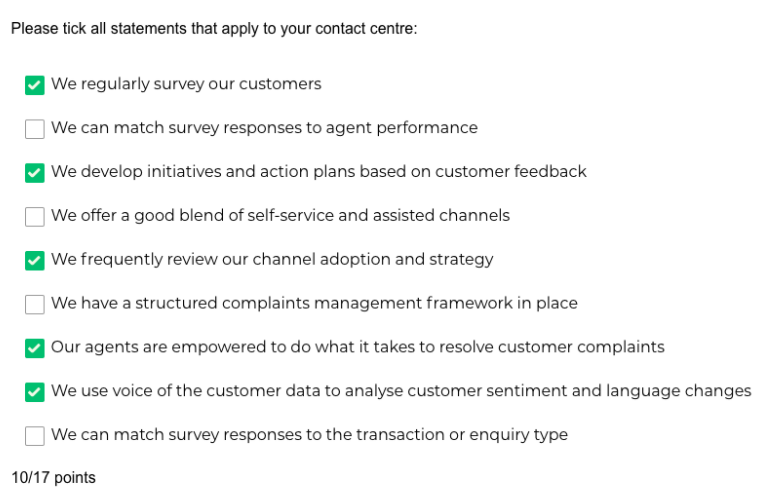You don’t know what you don’t know. So what can you do to find out what you don’t know, so you can take steps to start to know it?! This is one of the biggest challenges many contact centre leaders are faced with.
Knowing what initiatives to prioritise first, is next in line. Will the improvement you’ve chosen produce the results you need? Will it improve efficiency of operations or effectiveness of staff? Does it align with business objectives?
A contact centre is a delicate ecosystem of moving parts that need to operate in harmony to drive great results for customers, employees and the business.
This is where the Customer Excellence Maturity Assessment, or CXMA for short, proves to be the most beneficial self-assessment tool every customer service leader needs.
What is the Customer Excellence Maturity Assessment (CXMA)?
CXMA is a self-assessment tool that allows contact centre leaders to assess the maturity of the six pillars of operational maturity, which are:
People and capability
Operating rhythms
Performance and insights
Planning and efficiency
Technology and tools
Customer journey
The 6 pillars combined become the wheel of operational mastery. If all 6 pillars are working together harmoniously it means employees are happy, customers are happy and your contact centre operations are running smooth and steady.
Still need some clarity? Let’s dive a little deeper.
How does this relate to contact centre metrics and performance?
Each pillar contributes to one of the 3 key X-Factors, which are critical to running a great contact centre. Check out the figure below —
Employee eXperience: People & Capability + Operating Rhythms
Customer eXperience: Customer Journey + Technology & Tools
Workforce eXcellence: Performance & Insights + Planning & Efficiency
CHECKLIST FORMAT
The structure of the assessment essentially asks questions that are based on the 6 pillars and provides the responder a checklist of things they could implement to improve their maturity (see example response below). i.e. anything you haven’t ticked could be an initiative for you to focus on.
Based on how you answer each question for each pillar, you will be assigned a maturity score. On completion, you will instantly be provided with an overall maturity score and a summary of your responses.
Regardless of the overall stage of maturity, if you’re in a balanced wheel it means a balanced experience — for your people, your customers, and your business.
An imbalanced wheel however, creates discourse and disconnected results across your whole operation. If one segment of the wheel is underperforming, it has a flow-on impact to the rest of the wheel. Unhappy employees? Your customers will be unhappy too. Ineffective resource planning? Both your employees and customers will suffer as a result.
Each pillar supports (or compromises) the maturity of the others. For example:
Scenario 1
If you have designed a world-class customer journey, but still use primitive technology and tools to support the implementation of that journey, you will not be able to maximise results from the customer journey.
Scenario 2
If you have great people and capability in your organisation, but limited performance and insights driving your decision making, your team can only be so effective, no matter how great they are.
There is also an optional report available which will summarise your maturity score per pillar, and provide some recommendations and insights on improvements you can focus on to enhance your maturity and balance your wheel.
Why is CXMA important and how does it apply in a contact centre?
It provides contact centre leaders with insights and information to support decisions on where to focus their improvements and what to prioritise within their contact centre. As a 3rd party data source, contact centre leaders can use results to support conversations with executives to gain support for prioritising improvement initiatives.
How does CXMA benefit the contact centre?
CXMA benefits the contact centre by shining a light on the areas of imbalance which are causing employee frustration, customer dissatisfaction and executive lack of confidence/buy-in. This highlights key focus areas for initiatives that will lift performance and outcomes in these areas.
How does it benefit contact centre leaders?
CXMA benefits contact centre leaders by giving them a short-cut to helping prioritise the improvement actions they need to focus on, and strengthening their ideas to gain buy-in and support. CXMA also provides them a channel of inspiration to trigger new thinking, as well as affirmation, which is especially useful for those who don’t have a peer group of other contact centre leaders to discuss their ideas and issues with.
How does CXMA benefit on an executive level?
CXMA allows an executive to understand the operational maturity of their contact centre so they can best direct and support their operational leaders.
What sort of problems does CXMA help reveal within a contact centre?
Our leaders are responsible for driving process improvements, however don’t have access to detailed trend data for inbound enquiries to help them effectively identify opportunities for improvement (High People & Capability, Low Performance & Insights).
We have consistent and well-run daily huddles, however we don’t have the forecasting insights to help us make effective real-time management decisions in these forums (High Operational Rhythms, Low Performance & Insights.
We’ve got market-leading technology, but we’re not realising its full potential because we have an inexperienced team using it (High Tech & Tools, Low People & Capability).
We get great data from our customer surveys, but we can’t map that to an agent or interaction which limits its value (Customer Journey Response Data)
We’ve got market leading technology, however our business process causes delays and friction for our staff and customers (High Tech & Tools, Low Customer Journey).
The scenarios here are endless, due to the intricate, interwoven operational landscape that is a contact centre.
If you’d like to pinpoint your own maturity scores and identify areas for improvement, complete your CXMA for free now.




